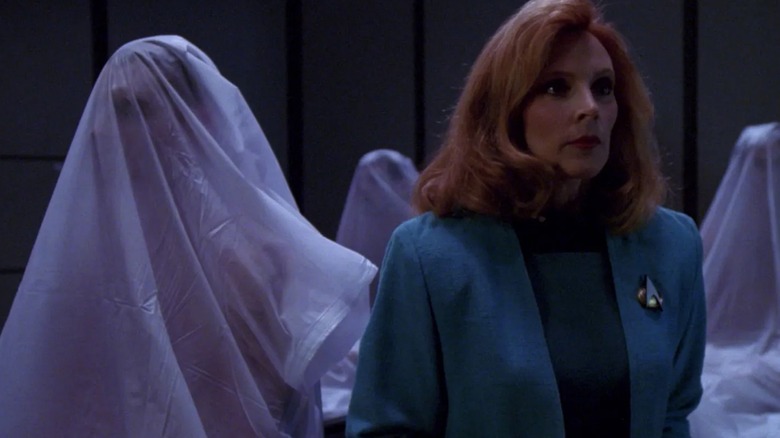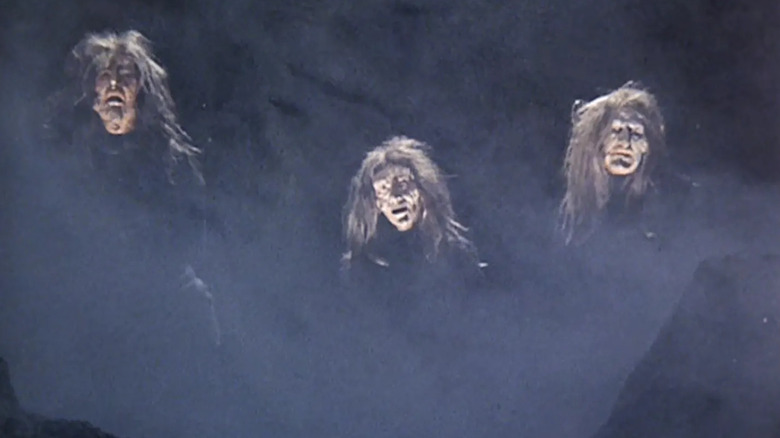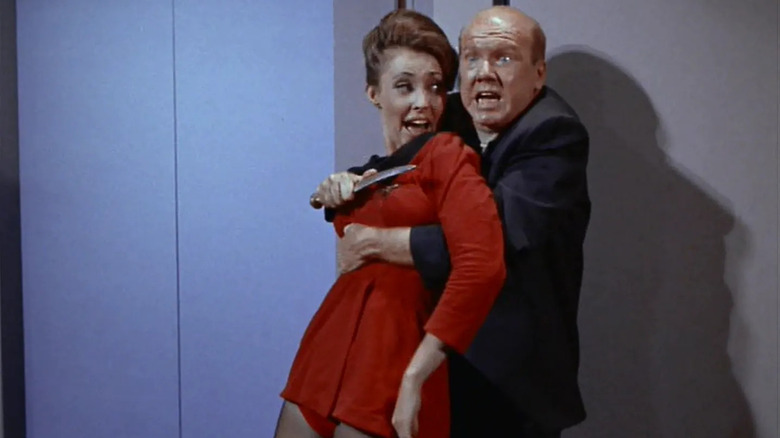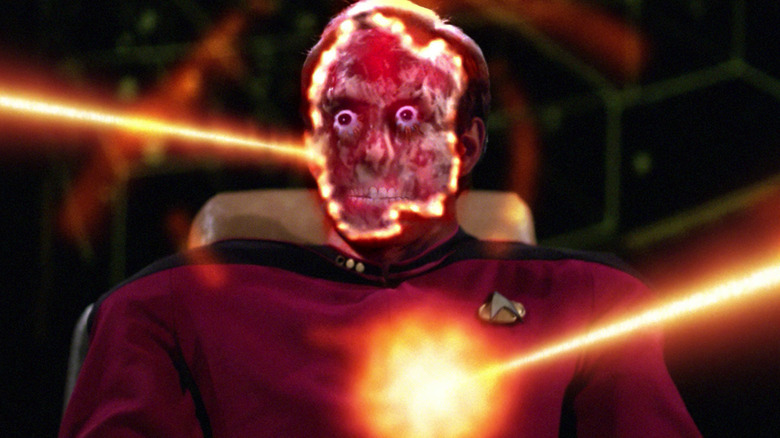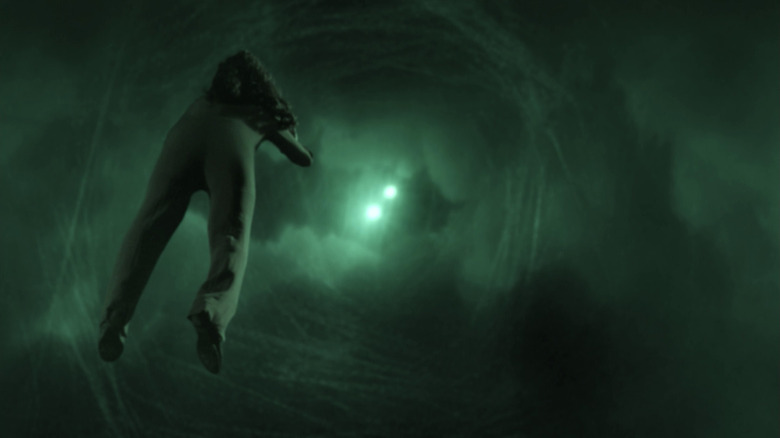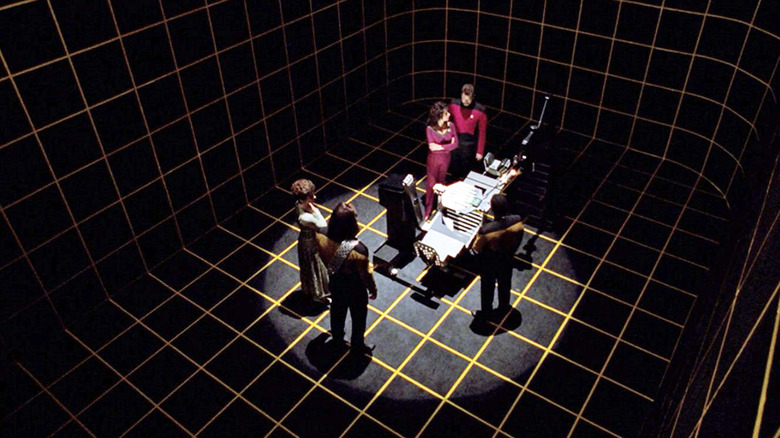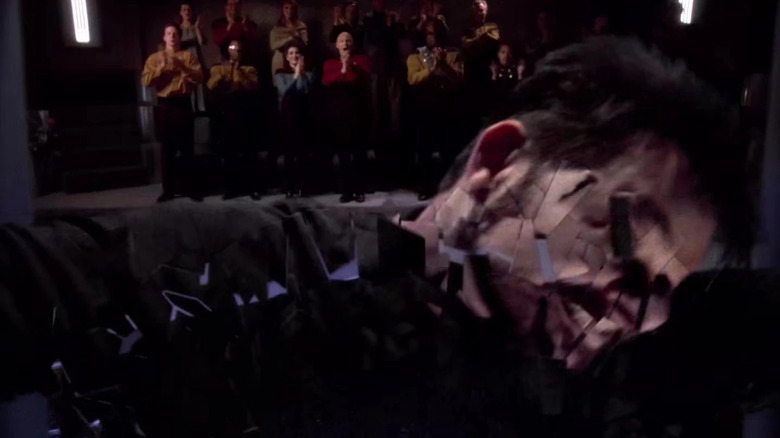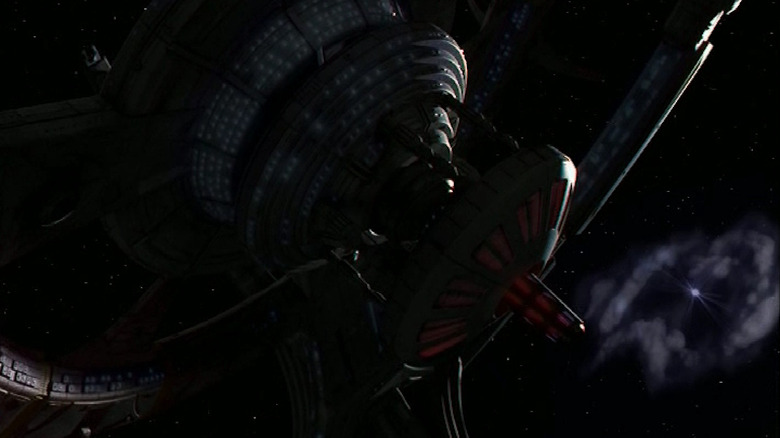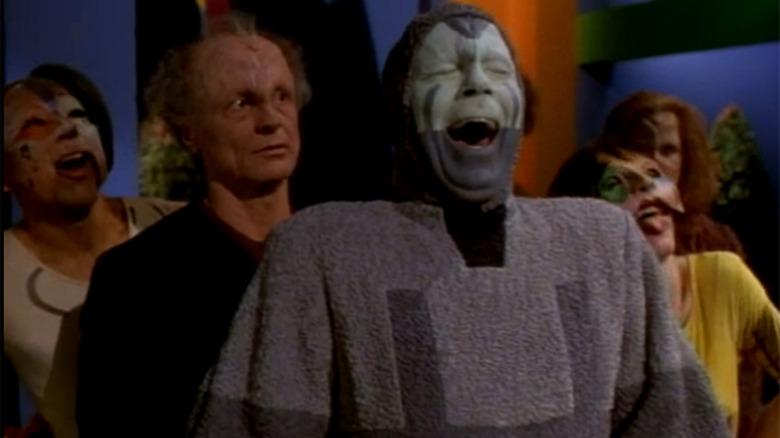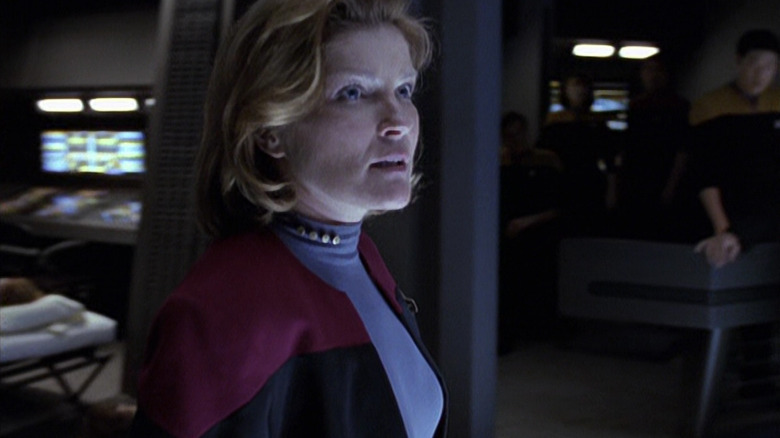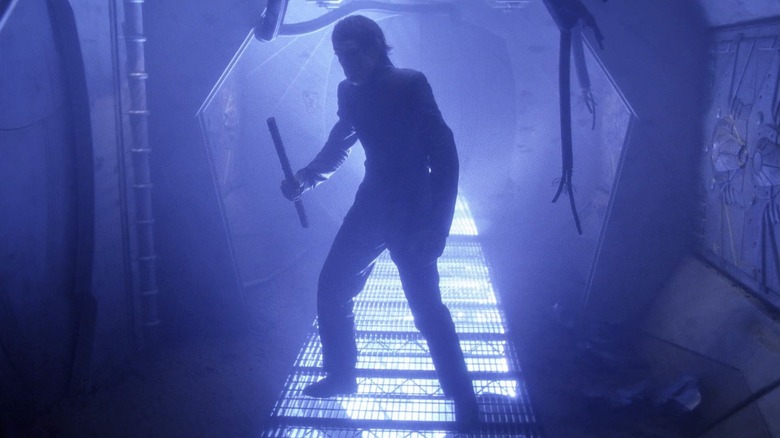10 Terrifying Star Trek Episodes To Watch After This Week's Strange New Worlds
This week's episode of "Star Trek: Strange New Worlds" is, essentially, the show's take on "Alien." A crew of officers, trapped in a downed starship, must face a species of vicious, poison-spitting lizards that incubate their young inside host bodies. It's a straight-up monster movie in miniature. It's tragic — several characters die — and it's scary.
"Star Trek" fits under the banner of several genres. Primarily, it is a science fiction show, yes, specifically a pioneering space Western; Gene Roddenberry initially pitched it as "'Wagon Train' to the stars" in reference to the hit 1957 TV series. Secondarily, "Star Trek" is a workplace drama, following a crack team of diplomatic experts on their job-related struggles; when "Star Trek" begins delving into the minutiae of management styles and command structures, this Trekkie's little heart sings. Tertiarily, "Star Trek" may be deemed a military show, focusing on formality, uniforms, and respect of the captain's good judgement. Although not about necessarily tactical prowess or military might, the wartime technicals of ships and weapons play a large part on every Trek series.
Quaternarily, however, "Star Trek" could easily be described as a horror show, especially the 1966 series' first season. Many, many horrible things happen to Enterprise crewmates in season one. So many, in fact, that a critic may be forgiven for comparing it to "The Twilight Zone." Over the years, Trek has revisited terrifying space monsters time and again, highlighting that the cosmos, while often filled with interesting and exciting new cultures, is still vast and cold and horrifying.
Below are the vastest, coldest, and most horrifying episode of "Star Trek."
Catspaw
"Catspaw" first aired on October 27, 1967, making it a proper Halloween episode of "Star Trek." In it, the Enterprise encounters a mysterious medieval castle on a distant planet, occupied by a pair of mysterious sadists named Korob (Theo Marcuse) and Sylvia (Antoinette Bower) who seem to possess infinite power. Sylvia occasionally turns herself into a black cat, and seems to hold power over the Enterprise itself. When she dangles an Enterprise-shaped medallion over a candle, the ship begins to heat up in orbit.
These sadistic Halloween creatures were presaged by a chorus: Outside the castle, a trio of Macbethian witches gave Kirk (William Shatner) grave warnings about what is to come. By the end of the episode, Kirk and crew learn that Korob and Sylvia are in fact cosmic entities with facial tentacles, like Elder Gods out of an H.P. Lovecraft story. They can shapeshift, and Sylvia can appear as a giant cat. The special effects aren't terribly sophisticated, but they are incredibly effective.
Eventually Kirk smashes the widget the Elder Gods required to manipulate reality, their castle vanishes, and the day is saved. To highlight their defeat, Kirk and company see the aliens' true form: They are miniature blue fluff creatures — little marionettes — who die and disintegrate when they come into contact with air. Elder Gods, perhaps, but no longer vast. There is a tragedy in watching the little critters die.
Wolf in the Fold
Not to be outdone by "Catspaw," "Star Trek" continued apace the following Christmas with "Wolf in the Fold," which aired on December 22, 1967. In the episode, it appears that Scotty (James Doohan), while putting the moves on a young lady (Tanya Lemani), went insane and stabbed her to death in a foggy alleyway. There are immediate echoes of Jack the Ripper, and Scotty is apprehended for murder. Scotty, claiming not to remember what happened, is connected with a medium who holds a séance (!) to read his mind. The medium begins ominously mentioning an ancient evil with a hunger that cannot be sated. Kirk, through some investigation, finds that there is a noncorporeal entity in their midst, and that it can possess people and force them to commit murder. It's, for lack of terms, a demon. Oh yes, and this demon once lived on Earth as ... Jack the Ripper.
The demon feeds on fear, and, in the episode's climax, possesses the Enterprise's computer, scaring everyone on board. Luckily, Dr. McCoy (DeForest Kelley) is on hand to administer what is essentially marijuana, causing the crew to mellow out and not be so worried, man. And since the demon is now part of a ship's computer, he strains the demon's brain by asking it to calculate pi to its final digit. The demon flees into a person (John Fiedler), Kirk beams him into space, and the mystery of Jack the Ripper comes to a close.
The first half of "Wolf in the Fold" is an exciting serial killer thriller with ghostly elements. Kirk's solution makes the monster seem all the less terrifying. Logic and clear-headed thinking will defeat even demons.
Conspiracy
Trekkies all agree that the best episodes of any series are the ones wherein a mold of Paul Newman's head, stuffed with meat, is blown up.
That was certainly the case with the "Star Trek: The Next Generation" episode "Conspiracy" (May 9, 1988), the penultimate episode in the show's first season. Throughout the season, there were several scenes of Starfleet Admirals confiding to Captain Picard (Patrick Stewart) that there may be a conspiracy at play in the upper echelons of the Federation. The conspiracy came to a head (heh) when several shadowy officers attempt to induct Picard and Commander Riker (Jonathan Fakes) into their ranks. It turns out that humans are playing host to large, pink, mind-controlling stag beetles that live in their throats. When a host is killed, the beetle exits and climbs into the mouth of its next host.
The episode climaxes with one of the most violent scenes in "Next Generation" history. A character named Remmick (Robert Schenkkan) reveals himself to be the host of the queen parasite, and Picard and Riker, with the utmost diplomacy, blast his face open with phasers. When a big slimy screaming arthropod emerges from Remmick's gloppy, tattered abdomen, they blast that too. Yes, the mold for Remmick's exploding head was indeed formed using an old mold of Paul Newman's head left in the Paramount props department. The explosion of Remmick is less a "Star Trek" moment, and more like something out of a Universal monster movie. No child watches the scene without being marked.
Night Terrors
Handily one of the scariest episodes of any Trek series is NextGen's "Night Terrors" (March 18, 1991), an episode about hallucinations and madness. In it, the crew of the Enterprise find a derelict ship with only one survivor, a seemingly comatose psychic who seems locked in a perpetual state of speechless fear. The ship then becomes gravitationally trapped near a binary star system that eerily begins robbing the crew of their ability to reach R.E.M. sleep. No matter how long they are unconscious, the crew is never rested. They don't dream. Without rest, they become fatigued and begin hallucinating snakes in their beds, shuffling noises, phantom doorbells.
In the episode's most chilling scene, Dr. Crusher (Gates McFadden) hears movement in a cargo bay filled with dozens of dead bodies on gurneys. She looks around and sees that the bodies, wrapped in translucent body bags, are sitting up on their own. Not menacing her. Not speaking. Sitting up is enough. Dr. Crusher has to take several deep breaths, reminding herself that the visions aren't real.
Eventually Counselor Troi (Marina Sirtis) and Data (Brent Spiner), both immune to the effects of the binary stars' effects, are able to decipher a nightmare Troi had been having about a whispering space tunnel. By the end, the crew is restored, but not before a nap. Everyone is rattled, including the audience. Don't watch this episode late at night by yourself.
Schisms
People who were fans of both "Star Trek: The Next Generation" and of "The X-Files" in the mid-1990s (and we were legion) were distantly miffed that the Enterprise never encountered the famed alien "Greys" frequently mentioned in true-to-life accounts of alien abduction. Maybe it was because "Star Trek" is fiction, and alien abduction is ... gulp ... very much real. Maybe? For those unfamiliar with the lore, short, spindly, large-eyed space aliens have been known to visit Earth, float Earthlings out of their bedroom windows at night, and take them aboard their ships to perform odd medical experiments on them. The humans would be returned, sometimes miles away, with no memories of the events. These things were accepted as common facts in the early '90s.
"Next Generation" did feature their own version of alien abduction in the episode "Schisms," another Halloween episode that aired on October 19, 1992. Various random crew members begin having strange, fearful reactions to everyday objects. Worf (Michael Dorn) is startled to see a pair of hairdresser's scissors for instance. Troi, the ship's shrink, finds that said crew members are experiencing similar memories, and they convene on the holodeck to recreate a monstrous medical torture table they recall being strapped to. Eventually, the crew finds that they are indeed being transported off the ship by hooded, mysterious insect aliens and are indeed being subjected to medical experiments. Their motives are never determined.
Frame of Mind
It seems "Next Generation" was generous with their scares, perhaps a reaction to TV trends at the time — "Tales from the Crypt" and its many knockoffs were running concurrently with NextGen. Horror seemed to be a popular TV genre at the time. One of the more notable fright fests from the show's final season was "Frame of Mind," an episode about a mental institution, shattering layers of reality, and madness. In "Frame of Mind" (May 3, 1993) Riker has been getting a little too deeply into character for a play he has been roped into performing. He is playing a man committed to a mental institution who is dogged by fantasies and hallucinations. Riker himself soon beings having hallucinations, specifically of one alien crewmate (David Selberg), and eventually wakes up in an institution. He is told that "Riker" was the hallucination, and that he is, in fact, a convicted murderer being treated for severe mental illness.
Such episodes always resolve themselves well — "Star Trek: The Next Generation" wasn't suddenly going to become a hospital show — but they can be damaging to our personal sense of perspective. When Riker finally comes back to reality, he is unhappy with how easily his mind unraveled, even if it was at the hands of malevolent alien intrusion. We leave off with our world a little shaken.
Empok Nor
"Star Trek: Deep Space Nine" was typically too busy mucking about with heady sociopolitical themes and the implication of war to delve into the fantastical (the season 1 episodes "Move Along Home" and "If Wishes Were Horses" notwithstanding). When the show did introduce a fantastical story line — certain characters became inhabited by malevolent alien consciousnesses called Pah-wraiths — it was widely derided by even the most devout Trekkies. But on at least one occasion, "Deep Space Nine" indulged in a proper "haunted house" episode with "Empok Nor" (May 19, 1997).
In the episode, several members of the DS9 crew led by Chief O'Brien (Colm Meany) have to trek to a distant station — in the same design as theirs, allowing for reused sets — in order to salvage parts for engineering reasons. It turns out that the abandoned station is not only heavily booby-trapped, but there are elite cryogenically unfrozen soldiers stalking the corridors, high on drugs that make them even more hateful and xenophobic than they had been previously. The killers cannot be reasoned with, making them more similar to Michael Myers than to the Dirty Dozen.
Not so much supernatural as cautionary, "Empok Nor" is still chilling.
The Thaw
Handily the best episode of "Star Trek: Voyager," "The Thaw" (April 29, 1996) involved facing fear — quite literally.
The episode was about the Voyager crew finding a matrix of interconnected cryo-stasis tubes where a small group of people have been suspended for many years. To keep their minds active, their brains were wired into a simulation that would allow them to interact as if they were conscious. Sadly for them, a glitch in the simulation created an entity — an evil sadistic clown played by Michel McKean — built of their fears. When several Voyager crewpeople enter the simulation themselves, they find they cannot leave, doomed to be tormented by a fear clown until they die. McKean, best known for comedy roles, handily makes the Clown as terrifying as possible, able to out-think anyone who would stymie his torture games.
Ultimately, Captain Janeway has to ask the ultimate philosophical question: What does Fear want? Why are biological creatures hardwired with it? What does it expect us to do? The answers she arrives at will push Fear into the darkness. Thoughtful, heady, and scary, "The Thaw" is a highlight of the show.
The Haunting of Deck Twelve
The "Star Trek: Voyager" episode "The Haunting of Deck Twelve" (May 17, 2000) is a little frustrating as horror stories go, as the events in it may or may not be fictional. At this point in the show, the Voyager crew has taken several recovering Borg children on board, and are teaching them to rediscover their humanity. In "Haunting," the Borg kids wake up in the middle of the night, and the jolly Neelix (Ethan Phillips) tells them a scary bedtime story to get them back into bed. In the story, a certain deck on the ship became mysteriously haunted, with electrical discharges attacking the crew. Eventually Captain Janeway (Kate Mulgrew) surmises that the discharges are being caused by a rogue noncorporeal entity — effectively a ghost — that moved into the ship when it passed through a nebula. The ghost ends up forcing the entire crew off the ship, leaving Janeway behind to punish her and suffocate her for accidentally destroying its nebula home.
Was it true, or did Neelix make it up? If Neelix made it up, he essentially spends the episode engaged in a pitch meeting with Paramount executives. While there's nothing terribly original with noncorporeal ghosts infecting a ship (see "Wolf in the Fold" above), "Haunting" tries to tell the story in a spooky, shadowy fashion. It's not the scariest thing, but it will do as a bedtime story.
Impulse
Since "Star Trek: Enterprise" took place a century prior to the events of "Star Trek," there were a lot of technologies that viewers had taken for granted. Transporters were not safe for human use, there were no tractor beams (they had grappling cables), no shields (they polarized the hull plating), and ships didn't necessarily protect the crew from more dangerous cosmic rays. In "Impulse" (October 8, 2003), the ship's crew learn that an upcoming area of space called the Delphic Expanse requires extra shielding. The substance the Enterprise uses for the shield, however, contains a subtle neurotoxin that only affects Vulcans. It degrades their brains, and essentially turns them into mindless, violent zombies. Yes, dear reader, it is about zombie Vulcans.
"Impulse" — a play on words, as the ships on "Star Trek" use impulse engines — is filmed like a zombie movie, with Vulcans snarling and attacking like any of the fast runners from "28 Days Later." Chillingly, the Enterprise crew is unable to help the zombie Vulcan, barely escaping with their own hides in tact. When Captain Archer (Scott Bakula) learns that the shielding minerals will affect his Vulcan first officer, he elects not to use it. It is the decent thing to do.
